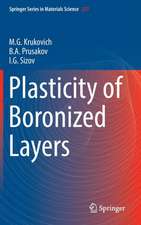Fundamentals of Tribology and Bridging the Gap Between the Macro- and Micro/Nanoscales: NATO Science Series II: Mathematics, Physics and Chemistry, cartea 10
Editat de Bharat Bhushanen Limba Engleză Paperback – 31 mar 2001
| Toate formatele și edițiile | Preț | Express |
|---|---|---|
| Paperback (1) | 1848.33 lei 6-8 săpt. | |
| SPRINGER NETHERLANDS – 31 mar 2001 | 1848.33 lei 6-8 săpt. | |
| Hardback (1) | 1855.11 lei 6-8 săpt. | |
| SPRINGER NETHERLANDS – 31 mar 2001 | 1855.11 lei 6-8 săpt. |
Din seria NATO Science Series II: Mathematics, Physics and Chemistry
- 18%
 Preț: 1272.32 lei
Preț: 1272.32 lei - 15%
 Preț: 644.30 lei
Preț: 644.30 lei - 18%
 Preț: 1235.76 lei
Preț: 1235.76 lei - 15%
 Preț: 649.87 lei
Preț: 649.87 lei - 18%
 Preț: 957.75 lei
Preț: 957.75 lei - 15%
 Preț: 656.58 lei
Preț: 656.58 lei - 18%
 Preț: 1235.43 lei
Preț: 1235.43 lei - 18%
 Preț: 960.13 lei
Preț: 960.13 lei - 18%
 Preț: 1225.79 lei
Preț: 1225.79 lei - 15%
 Preț: 666.41 lei
Preț: 666.41 lei - 18%
 Preț: 1835.07 lei
Preț: 1835.07 lei - 15%
 Preț: 640.71 lei
Preț: 640.71 lei - 18%
 Preț: 954.45 lei
Preț: 954.45 lei - 18%
 Preț: 1227.36 lei
Preț: 1227.36 lei - 15%
 Preț: 646.11 lei
Preț: 646.11 lei - 18%
 Preț: 948.61 lei
Preț: 948.61 lei -
 Preț: 400.10 lei
Preț: 400.10 lei - 18%
 Preț: 959.82 lei
Preț: 959.82 lei - 18%
 Preț: 944.19 lei
Preț: 944.19 lei - 18%
 Preț: 1838.38 lei
Preț: 1838.38 lei - 18%
 Preț: 1222.49 lei
Preț: 1222.49 lei - 18%
 Preț: 939.94 lei
Preț: 939.94 lei - 18%
 Preț: 950.66 lei
Preț: 950.66 lei - 18%
 Preț: 957.44 lei
Preț: 957.44 lei - 15%
 Preț: 656.74 lei
Preț: 656.74 lei
Preț: 1848.33 lei
Preț vechi: 2254.06 lei
-18% Nou
Puncte Express: 2772
Preț estimativ în valută:
353.73€ • 367.93$ • 292.02£
353.73€ • 367.93$ • 292.02£
Carte tipărită la comandă
Livrare economică 15-29 aprilie
Preluare comenzi: 021 569.72.76
Specificații
ISBN-13: 9780792368373
ISBN-10: 0792368371
Pagini: 964
Ilustrații: XLIV, 964 p.
Dimensiuni: 155 x 235 x 49 mm
Greutate: 1.35 kg
Ediția:2001
Editura: SPRINGER NETHERLANDS
Colecția Springer
Seria NATO Science Series II: Mathematics, Physics and Chemistry
Locul publicării:Dordrecht, Netherlands
ISBN-10: 0792368371
Pagini: 964
Ilustrații: XLIV, 964 p.
Dimensiuni: 155 x 235 x 49 mm
Greutate: 1.35 kg
Ediția:2001
Editura: SPRINGER NETHERLANDS
Colecția Springer
Seria NATO Science Series II: Mathematics, Physics and Chemistry
Locul publicării:Dordrecht, Netherlands
Public țintă
ResearchCuprins
1. History.- History of Tribology and Its Industrial Significance.- 2. Adhesion and Friction.- Friction, Wear, Lubrication, and Materials Characterization Using Scanning Probe Microscopy.- Atomic Scale Origin of Adhesion and Friction Viscoelastic Effects in Model Lubricant Monolayers.- Atomic-Scale Stick Slip.- Dissipation Mechanisms Studied by Dynamic Force Microscopies.- Frictional-Force Imaging and Friction Mechanisms with a Lattice Periodicity.- Atomic Scale Origins of Force Interaction.- Dynamic Friction Measurement with the Scanning Force Microscope.- Towards the Ideal Nano-Friction Experiment.- Investigation of the Mechanics of Nanocontacts Using a Vibrating Cantilever Technique.- A Scanning Probe and Quartz Crystal Microbalance Study of C60 on Mica and Silver(111) Surfaces.- Interactions, Friction and Lubrication Between Polymer-Bearing Surfaces.- Effect of Electrostatic Interactions on Frictional Forces in Electrolytes.- Adsorption of Thin Liquid Films on Solid Surfaces and its Relevance for Tribology.- Theory and Simulations of Friction Between Flat Surfaces Lubricated by Submonolayers.- Friction Mechanisms and Modeling on the Macroscale.- Experimental Aspects of Friction Research on the Macroscale.- The Anisotropic Friction Characteristics of Crystalline Materials: A Review.- Relationship Between Structure and Internal Friction in CoPt and FePd Alloys.- Direct Measurement of Surface and Interfacial Energies of Glassy Polymers and PDMS.- A Model for Adhesive Forces in Miniature Systems.- Simple Model for Low Friction Systems.- Ultra-Low Friction Between Water Droplet and Hydrophobie Surface.- A FM as a New Tool in Characterisation of Mesoporous Ceramics as Materials to Tribological Applications.- Discussion Forum Report: Bridging the Gap Between Macro- and Micro/Nanoscale Adhesion and Friction.- 3. Wear.- Modeling (and) Wear Mechanisms.- Surface Damage Under Reciprocating Sliding.- Wear Particle Life in a Sliding Contact Under Dry Conditions: Third Body Approach.- Fretting Wear Behaviour of a Titanium Alloy.- Wear Measurements and Monitoring at Macro- and-Microlevel.- Slurry Erosion: Macro- and Micro- Aspects.- Macro-and Micro Kelvin Probe in Tribological Studies.- Thermomechanics of Sliding Contact: When Micro meets Macro.- Nanostructuring of Calcite Surfaces by Tribomcchanical Etching with the Tip of an Atomic Force Microscope.- Atomic-Scale Processes of Tribomechanical Etching Studied by Atomic Force Microscopy on the Layered Material NbSe2.- Determining the Nanoscale Friction and Wear Behavior of Si, SiC and Diamond by Microscale Environmental Tribology.- On Some Similarities of Structural Modification in Wear and Fatigue.- The Mesostructure of Surface Layers of Metal Under Friction with Relatively High Contact Stress.- The Effect of Impact Angle on the Erosion of Cermets.- Wear Mechanism of Carbon Material-Steel Slide Bearing in Polluted Atmosphere.- Nanomechanical Properties of Brittle Matter.- Testing Tribological Behaviour of loo-Beam Mixed Surface Layers.- Tribological Studies of DLC Films Containing Different Amount of Silicon Coated by Reactive Ion Plating.- Tribological Aspects of Wear of Laser-Sintered Rapid Prototype Tools.- Discussion Forum Report: Bridging the Gap Between Macro- and Micro/Nanoscale Wear.- 4. Lubrication.- On the Effects of Roughness on Structures, Solvation Forces and Shear of Molecular Films in Nano-Confinement.- Nanoscale Lubrication and Friction Control.- Tribology of Ideal and Non-Ideal Surfaces and Fluids.- Nanoscale Wetting and De-Wetting of Lubricants with Scanning Polarization Force Microscopy.- The Study of Very Thin Lubricant Films in High Pressure Contacts Using Spacer Layer Interferornetric Methods.- Scaling Issues in the Measurement of Monolayer Films.- Hew Electrolytes for Electrochemical Study in Hydrocarbon Solution.- Limiting Friction in a Slider-Disk Interface with Nanometer-Scale Lubricant Films.- Friction in Lubricated Contacts: From Macro- to Microscale Effects.-The Present State of the Art on Degradation Models of Perfluoropolyethers with DLC Coatings in Thin-Film Magnetic Rigid Disks.- fluid Film Lubrication with Applications to Machine Elements.- Flow Modeling of Thin Films from Macroscale to Nanoscale.- Discussion Forum Report: Bridging the Gap Between Macro- and Micro/Nanoscale Lubrication.- 5. Applications.- Micro-and Nanostructures: Preparation and Applications.- Micro/Nanoscale Tribology of MEMS Materials, Lubricants and Devices.- Macro- and Microtribology of Information Storage and Retrieval Devices.- High Spatial Resolution Chemical Imaging of Tribo-Surfaccs in Magnetic Recording.- Analysis and Testing of Miniature Motors for Precision Engineering.- Permanent Magnetic Levitation and Stability.- Load Carrying Capacity of Heavy-Duty Porous Journal Bearings.- Manufacturing Applications of Multi-Scale Tribology.- Condition Monitoring Tools for Tribologists.- Author Index.


















